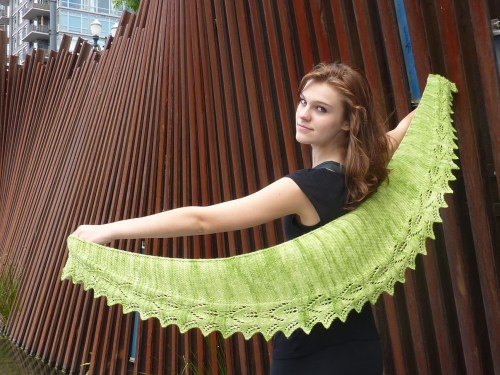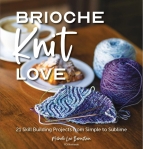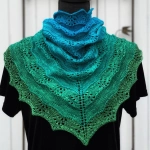I’m planning my cast on for the Garland KAL. My prototype shawl is very wide and shallow. I’d like to make my next one deeper, like test knitter Rachel’s, but also as wide as it can be with the amount of yarn I have. I was conservative with Rachel’s test knit to make sure the deeper shawl would be wide enough with about 400 yards of yarn, even though the Cashy Lite was 495 yards.
How do you know if you should make the wider, shallower shawl, or the narrower, deeper shawl? Part of it depends on how you like to wear your shawl.
If you have about 400 yards of yarn, your deeper shawl will probably be most comfortable worn centered on your back. The ends don’t provide a lot of overlap for wearing this like a scarf. Rachel’s shawl took 390 yards at 6 st/inch.
If you use those 400 yards to make a shallower shawl, you’ll get more overlap at the ends.
If you have 450 yards or more, the shallower shawl will be super wide like my prototype. This one took 455 yards at 5 st/inch. (I’m planning to aim for 5.5 or 6 st/inch next time, for a slightly firmer fabric.)
It’s luxuriously wrappable, but I don’t know that I’d wear it centered on my back. Maybe if I were taller…
I’m planning to split the difference this time and go deep *and* wide. How?
The pattern instructions tell you how many repeats wide to make your shawl, but you can easily customize this for the amount of yarn you have. This is because the shawl is knit from side to side. You start at the right end, increase towards the center back, and then decrease to the left end. With a little math, you can easily adjust the size of your shawl without fear of running out of yarn.
You’ll need a kitchen scale, one of my favorite knitting tools. Weigh your yarn before you begin. Half of this yarn will go to the increase section of your shawl, and half will go to the decrease section. Weigh your yarn after every 24 row repeat. (Weigh your yarn in grams, because it’s a more precise measure on the scale.) This will show you how much yarn each repeat takes. The amount increases gradually with each repeat, because you’re increasing the number of stitches with each repeat. You’ll need to figure in enough yarn for the center repeat, which has no increases or decreases, but the center repeat will weigh about as much as the repeat before and after it. When you are halfway through that center repeat, you need to have at least half your yarn left for the decreases! (You don’t really need to start weighing your yarn until the 7th repeat, but it doesn’t hurt to know the numbers.)
If you don’t want to do any figuring or customizing, go ahead and knit according to the pattern directions.
So, deep or shallow? What’s your Garland going to be? Beads? No beads? I’m going for beads! I like the bling, and the little bit of extra heft and drape they give the fabric.
I’m looking forward to getting my yarn, Knitted Wit’s Cashy Lite in Peacock. She’s dyeing today! Did you order yarn from Knitted Wit, or are you using your own? If you ordered from Lorajean, I’m tucking in a little goodie for you with your yarn.
Looking forward to casting on, June 10!
























Is there going to be an option to make the ends of the shawl into a point ?
Hi, Patti: No points on this shawl. The ends are as wide as the leafy border.
This is going to be fabulous. Thank you for the info on how to use all the yarn in the skein. I love shawls that are big enough to wrap around.
You’re welcome! I like to use as much of the yarn as I can, and this construction makes it easy to do that.